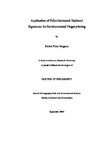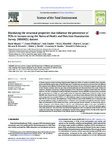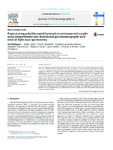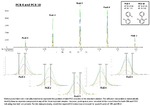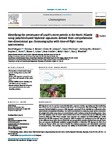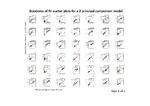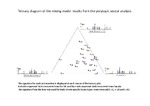Application of Polychlorinated Biphenyl Signatures for Environmental Fingerprinting
| dc.contributor.supervisor | Lohan, Maeve | |
| dc.contributor.author | Megson, David Peter | |
| dc.contributor.other | School of Geography Earth and Environmental Sciences | en_US |
| dc.date.accessioned | 2014-10-15T08:59:32Z | |
| dc.date.available | 2014-10-15T08:59:32Z | |
| dc.date.issued | 2014 | |
| dc.identifier | 10360805 | en_US |
| dc.identifier.uri | http://hdl.handle.net/10026.1/3135 | |
| dc.description | Chapter 2 has been produced based on the original research of Megson et al., (2013b), which was published in Science of the Total Environment (DOI: http://dx.doi.org/10.1016/j.scitotenv.2013.04.082) (presented as Appendix A). Chapter 3 is based in part on the original research of Megson et al., (2013a), which was published in the Journal of Chromatography A (DOI: http://dx.doi.org/10.1016/j.chroma.2013.10.016) (presented as Appendix B). Chapter 5 has been produced based in part on the original research of Megson et al. (2014), which was published in Chemosphere (DOI: http://dx.doi.org/10.1016/j.chemosphere.2014.04.061) (presented as Appendix D). | en_US |
| dc.description.abstract |
Polychlorinated Biphenyls (PCBs) are a group of 209 ‘man-made’ chlorinated organic compounds that were widely used in the 20th century for a variety of industrial uses. PCBs were first commercially produced in the 1929 and were manufactured until the 1980s when their use was phased out due to environmental and human health risks. However, due to their widespread use and persistence they are ubiquitous in the environment and remain a contaminant of concern. The structural properties that determine the persistence of PCBs in humans were therefore elucidated by statistical analysis of data from the National Health and Nutrition Examination Survey (NHANES). PCBs with chlorine bonding in the 2,5-and 2,3,6- positions (and 2- in di- and tri-chlorinated congeners) were rapidly biotransformed and so can be classed as episodic congeners whereas PCBs with chlorine bonding in the 2,3,4-, 2,4,5-, 3,4,5-, and 2,3,4,5- positions were more resistant to biotransformation and can therefore be classed as steady state congeners. A fundamental requirement of using PCB signatures for environmental fingerprinting is an effective analytical method capable of producing high resolution signatures from biological samples. An extraction and clean-up method was developed that was successfully applied to different biological matrices (blood and tissues). A two dimensional gas chromatography with time of flight mass spectrometry (GCxGC-ToFMS) method was designed and optimised to provide a congener specific method capable of identifying 200 out of the 209 PCBs, with detection limits in human serum in the range of 1 to 10 ng g-1 lipid. The extraction and detection methods were used to determine the source of PCB contamination and age date exposure in workers at a transformer dismantling plant. A total of 84 different PCB congeners were identified in the sera of 30 workers with concentrations of the 7 indicator PCBs ranging from 1.2 - 39 μg g-1 lipid. Analysis of PCB signatures was able to distinguish recent from prolonged exposure and also identified an additional source of inhalation exposure in a subgroup of workers. Analysis of 12 different tissue types obtained from the common guillemot (Uria aalge) suggested a high degree of perpetuation between the PCB signature in different tissue types. This shows that comparative assessments can be undertaken between animals using different tissue types and that small (1 g) samples of blood can be used as a non-lethal sampling technique. The regional provenance of 25 wrecked Leach’s storm petrels (Oceanodroma leucorhoa) was also determined using PCB signatures. Results from GCxGC-ToFMS analysis revealed distinctively different PCB signatures in birds from Canada and Europe. The findings reported in this thesis enhance our understanding of PCB signatures in the environment and show how they can be used effectively to age date and identify the source of exposure in humans and animals. | en_US |
| dc.language.iso | en | en_US |
| dc.publisher | Plymouth University | en_US |
| dc.subject | PCBs | en_US |
| dc.subject | Polychlorinated biphenyls | en_US |
| dc.subject | Comprehensive two-dimensional gas chromatography | en_US |
| dc.subject | GCxGC | en_US |
| dc.subject | NHANES | en_US |
| dc.subject | Age dating | en_US |
| dc.subject | Biotransformation | en_US |
| dc.subject | Biomonitoring | en_US |
| dc.title | Application of Polychlorinated Biphenyl Signatures for Environmental Fingerprinting | en_US |
| dc.type | Thesis | |
| plymouth.version | Full version | en_US |
| dc.identifier.doi | http://dx.doi.org/10.24382/4667 |
Files in this item
This item appears in the following Collection(s)
-
01 Research Theses Main Collection
Research Theses Main


